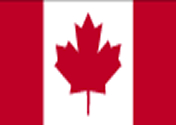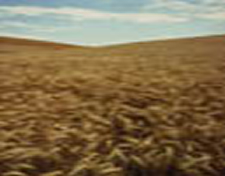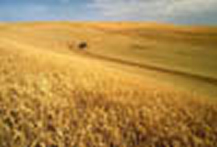Geographic Indications and International Trade (GIANT)
 Versus
Versus
1. Abstract
The wheat trade industry in North America has been an
important industry ever since Europeans came across the vast prairies of the
west and northwest. Red wheat in particular was transplanted to North America
by Russian Mennonites between 1874 and 1884. The Russian Mennonites were a religious
nationality who emigrated to the United States and Canada because of increasing
controls levied by tsarist Russia. This people sustained themselves on agriculture
and the fertile lands of the Crimea peninsula. The Mennonites were not native
to Russia either, emigrating there from northern Germany and the Netherlands,
after the start of the Protestant Reformation in pursuit of a secluded farming
community. The USDA followed this introduction of a new crop by also introducing
types of red wheat from Eastern Europe in 1900. The industry itself hit a major
boom after the Industrial Revolution when new machines provided much needed
efficiency in harvesting and processing the wheat. Both Canada and the United
States now comprise the greatest bloc of wheat trade in the world, and from
this competition between the two countries has emerged. The latest in a long
list of arguments between the two over fair trade is now being decided upon.
The question now raised is whether or not the United States unfairly placed
tariffs on Canadian Red Spring and Durum wheat, and has the Canadian Wheat Board,
the primary face of Canadian wheat, undersold the value of these kinds of wheat,
and received unfair government support? Another factor playing into this case
is an environmental issue involving a push to grow what is called Roundup Wheat,
which is able to sustain the popular herbicide. This type of wheat would cause
harm to Canadian farmers because consumers are not willing to buy this kind
of wheat. Canadian Red Wheat and Durum is sought out for its premium pigment
and quality, and the use of Roundup Wheat would readily cut into that supply.
This case study will attempt to provide some of the relevant background into
this trade conflict and its environmental dimension.
2. Description
The question of whether the Canadian Wheat
Board is dumping and unfairly subsidizing wheat into the United States has been
questioned since 1989. Dumping is the importing of goods at below market level
prices thus injuring the receiving country’s own farmers. In 1974 the
United States Congress passed legislation in the Trade Act that was an effort
to prevent dumping.The products in question are Red Wheat and Durum. American
farmers, more specifically organizations like the NDWC, are out to see the dissolution
of the CWB. Out of the twelve challenges only two have ever gotten to this point.
In this latest round of challenges, the United States Department of Commerce
implemented a raise in tariff prices to 14.16 percent on Canadian red sring
wheat and 13.55 per cent on durum for every bushel. Some of the American farmers
that have voiced their opinion saying as Mr. Hank Zal stated in his interview
with Minnesota Public Radio that "it's [CWB] unfair competition that they
do it that way. It's not fair to me as a farmer down here." This is just
one complaint about the CWB that is based on misinformaton that will be explained
below.
The Canadian Wheat Board is an organization made up
of farmers based in Winnipeg, Manitoba formed in 1935 to help fight bankruptcy
and now represents 85,000 farmers. The CWB is the largest single seller in the
world consisting of an astounding twenty percent control of the international
market. Canada, however, is not the leading exporter of wheat. That distinction
belongs to the United States. All revenues from this robust trade is returned
to the farmers less the overhead expenses, and the board is comprised of ten
elected and five appointed by the Canadian government. The NDWC claims that
the wheat exported is done so by government subsidizing it through help with
exportation and federal guarantees of CWB borrowings. These are the only two
allegations of countervailing that have any merit to them. Allegations of an
imposition of revenue caps on major railways' western grain traffic, and support
for short line and branch line railways was thrown out by the Department of
Commerce.

The North Dakota Wheat Commission’s case is weak.
In fact, Canada garners support from prominent milling operations inside the
United States. Some of these organizations include the American Italian Pasta
Company, the largest pasta producer in the U.S. and many millers who are part
of the North American Millers Association. Many of these organizations have
come out and stated quite the opposite to what the NDWC. In fact, Alan Koenig,
director of grain for Milner Milling and Pendleton Flour Mill stated that “in
all my years in the grain industry, I have never seen Canadian wheat priced
cheaper than U.S. wheat. This flies in the face of the NWDC’s claim of
dumping. Perhaps the most ringing endorsement was made by executives from NAMA,
an American pasta company, in which an executive said “from my nine years
of direct dealings with the Canadian Wheat Board I can testify to the fact that
they have not and have never been underselling the U.S. durum prices.”
He also added that “we are willing to pay the premiums for Canadian durum
because we offset the cost with better mill yields and improved product quality…”
Canada has routinely sold their wheat above the United State's price.
Another flaw in the NDWC’s argument is that of
government unfairly subsidizing grain transport and the CWB. The OECD released
data which state that the United States government subsidizes wheat at ninety-three
dollars per ton while Canada subsidizes about forty-eight dollars per ton.
Recently, the International Trade Commission ruled that
the exporting of red wheat did cause injury to American farmers and sustained
the tariffs, while they rejected the tariffs on durum. The four member panel
voted two-two on the issue, but in the bylaws of the International Trade Commission
a tie goes to the plaintiff or the United States. The CWB, however, has now
submitted an appeal under chapter nineteen of NAFTA for a board of five customs
administrators to decide if their practices are injuring American farmers. The
CWB in an effort to bolster its position has employed the services of the federal
government along with Saskatchewan and Alberta. If this appeal does not go the
way the CWB would like, it is fair to expect that the CWB will take their case
to the World Trade Organization.
3. Related Cases
- NAFTA
= Study on the Free Trade Agreement between the U.S., Canada, and Mexico
- CIGAR
= Import ban on Cigars in Thailand
- VEAL=
Animal rights and veal in the U.K.
- ONTARIO = Canadian-United
States trade dispute over beer tax.
- WHEAT
= Wheat Trade between the United States and China
- MAIZE
= Case on hybrid maize and the impact it has on trade relations between U.S.
and European Union
- SALMON
= Dispute over export of salmon between the U.S. and Canada
- USCANADA=
Dispute between United States and America and the Canadian subsidizing of
softwood lumber industry
- LOBSTER=
NAFTA case involving possible extinction of lobster
4. Author and Date:
Joel Zimmerman 11/12/03
5. Discourse and Status: Disagreement and In
Progress
6. Forum and Scope: Bilateral Trade
and NAFTA
7. Decision Breadth: United States
and Canada
8. Legal Standing: Treaty
9. Geographic Locations
a. Geographic Domain: North America
b. Geographic Site: Western North America
c. Geographic Impact: Western Canada
10. Sub-National Factors: Yes.
Agricultural commission boards are becoming more and more prevalent
in agricultural trade, evidenced by the fact that it
was not the U.S. Federal Government who rose to action, but namely the North
Dakota Wheat Commission. The boards as agents of the farmers themselves are
against the use of Roundup Wheat, and are effectively trying to look out for
the environmental quality in which the wheat is grown. They are against using
Roundup Wheat because of a drop in quality thus influencing the buyers who readily
buy Canadian wheat because of its quality and mill yields. Also, this case affects
primarily West Canada, though Canada's federal government is beginning
to get involved in the conflict when the case goes before the NAFTA panel.
 IV. Trade
Clusters
IV. Trade
Clusters
12. Type of Measure: Tariff
13. Direct v. Indirect Impacts: Direct
Direct impact on Canadian economy
14. Relation of Trade Measure to Environmental Impact
a. Directly Related to Product: Yes,
Food
b. Indirectly Related to Product: No
c. Not Related to Product: No
d. Related to Process: Yes, Deforestation
15. Trade Product Identification:
Canadian Hard Red Spring Wheat
16. Economic Data
2000-2001= Canadian West Wheat Exports to the U.S.= 1.6 million
metric tons
| Government Subsidies |
Canadian dollars per metric ton |
| 1. U.S. Wheat |
$130 C pmt |
| 2. EU |
$108 C pmt |
| 3. Canadian |
$31 C pmt |
| Leading Exporters of Wheat |
Value 2001 US$ '000 |
| 1. United States |
3,337,884 |
| 2. Canada |
2,549,895 |
| 3. Australia |
2,237,731 |
| 4. France |
1,791,255 |
| 5. Argentina |
1,301,503 |
| 6. Germany |
863,880 |
| 7. Kazakhstan |
N/A |
| 8. U.K. |
193,497 |
| 9. Hungary |
150,655 |
| 10. Spain |
145,074 |
The data shows that the United States claim of unfair subsidizing
of wheat trade is hypocritical because no other country in the world has the
level of subsidizing that the United States does. Legislative officials are
put into action representing boards like the NDWC because of parochial interests
and the desire to perform their duties as Congressmen for their constituents.
17. Impact of Trade Restriction:
High, this tariff closes the border for Canadian wheat farmers and the Canadian
Wheat Board.
18. Industry Sector: Agriculture
19. Exporters and Importers: Canada
and the United States
 VI. Other
Factors
VI. Other
Factors
25. Culture: No
26. Trans-Boundary Issues: No
27. Rights: No
28. Relevant Literature: No
Bibliography
Planet Wheat-Provides
a history of wheat.
Canadian Wheat Board, November 4, 2003 Press Release, August 29, 2003 Press
Release
North Dakota Wheat Commission, October 3, 2003 Press Release, August 29, 2003
Press Release
Office of Nafta and Intra-American Affairs, North American Free Trade Agreement,
Chapter 19.
Adrian Measner, "Challenges to the Canadian Grain Industry," Speech
give to National Trade Grain Council. 9/18/2003.
United State Department of Agriculture
World Trade Organization= Trade Data
"American farmers want retaliation against Canadian wheat farmers"
Minnesota Public Radio. Reporter Amy Jo Iman.
1/2001
 Versus
Versus
 I.Identification
I.Identification
